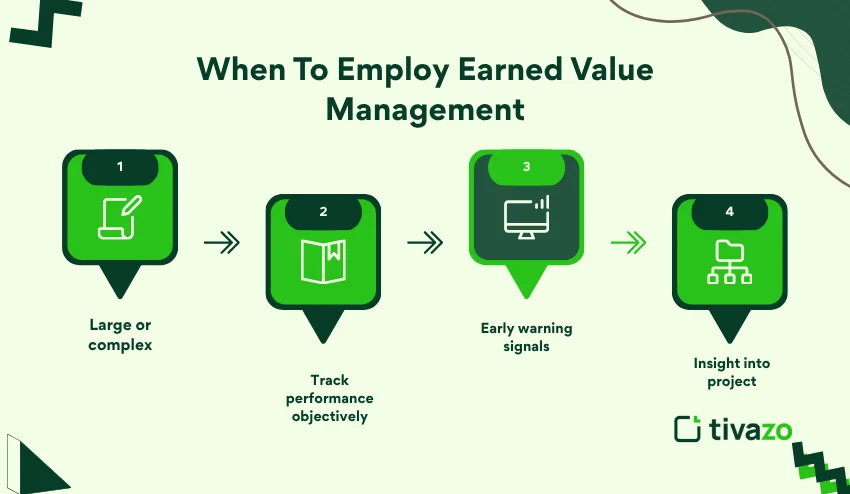Project management involves more than just starting a task and completing it; it requires the management of each resource, timeline, and cost to ensure everything is on schedule. This is where Earned Value Management (EVM) becomes one of your most valuable tools to objectively gauge real project performance.
Regardless of whether you are a project manager, analyst, or stakeholder, familiarity with earned value management will help you to identify project risks early in the project cycle to efficiently and confidently manage your expectations of performance and results.
What is Earned Value Management (EVM)?
Earned Value Management (EVM) is a project management technique for integrating scope, schedule, and cost in order to objectively evaluate the performance of a project and the progress made toward the desired outcomes.
Put simply, EVM helps you answer:
- How much work has been accomplished?
- How much has it cost?
- Is the project ahead or behind schedule?
EVM objectively examines the performance of an individual with respect to planned progress (what you should have accomplished) to actual progress (what you have accomplished).
EVM allows project managers to track project health using a formula-based, quantitative methodology for making informed and timely decisions early on in the project, while qualifying potential risk.
In real-time, EVM will help further work efficiently, control costs, and deliver projects on time and within budget.
When To Employ Earned Value Management
Earned Value Management (EVM) is most useful in the following situations:
- Large or complex projects with multiple tasks and dependencies.
- You prefer to track performance objectively rather than through subjective status indicators.
- You are interested in early warning signals of delay or overspending.
- Stakeholders are looking for insight into project performance based on data.

EVM is extremely useful for monitoring cost and schedule performance – simultaneously – so that you have end-to-end visibility of progress. It helps project managers discover issues before they become serious, make efficient adjustments to resources, and be more confident in decision-making. EVM is prevalent in construction, IT, defense, engineering, and manufacturing, where accuracy in tracking project performance is essential for achieving project success.
These elements build the basis for variance and performance index calculations in earned value management. They provide the data needed for project managers to measure cost efficiencies, schedule adherence, and the health of their project overall.
If weekly, bi-weekly, or monthly team meetings are set up to track PV, EV, and AC regularly, deviations can be detected earlier, and resources can be adjusted to ensure project goals for customers and stakeholders will be met by the agreed-upon date and budget limitations. Earned value management can turn bare data into meaningful knowledge and insights to assist in decision-making and risk management.
Why Implement Earned Value Management?
The implementation of earned value management allows you to:
- Detect cost overruns before they become a significant problem.
- Provide real-time monitoring of schedule variances.
- Forecast project results based on actual performance.
- Improve accountability and optimize resource utilization.
- Enhance stakeholder trust by providing transparent reports.

In summary, earned value management analyzes data into information for decision-making instead of being based on assumptions.
With earned value management, project managers can continuously monitor performance, identify performance trends, and, if necessary, adjust to keep the project on time and within budget. It also enables the project team to define resources for efficiency and effectiveness by quantifying project completion to deliver projects on time, on budget, and on scope.
The Basic Elements of Earned Value Management
The understanding of earned value management (EVM) starts with three key metrics:
| EVM Element | Explanation | Formula |
| Planned Value (PV) | Budgeted cost for the work planned to be completed by a given point in time | PV = Planned % × Total Budget |
| Earned Value (EV) | What is the value of the work actually accomplished at a specific point in time? | EV = Actual % × Total Budget |
| Actual Cost (AC) | Total cost incurred to complete the actual work performed. | AC = Sum of all actual costs |
Each of these components establishes the basis of variance and performance index metrics in earned value management. Together, they provide project managers with a view into cost efficiency, schedule adherence, and project health. With each project reporting PV, EV, and AC, the project team has the opportunity to identify deviations in time to reallocate resources and make sure that the team is reaching the project goals on time and on budget. Earned value management provides methods to take raw project data elements and develop them into information to help inform the decision-making and risk management process.
Calculating Variances and Indexes to Monitor Performance in EVM

Having obtained the Planned Value, Earned Value, and Actual Cost for the activity, we can now calculate the key indicators of EVM:
1. Cost Variance (CV)
- Indicates if the activity is either under or over budget. The formula is:
- CV = EV – AC
- A positive CV means that you are under budget, while a negative CV means that you are over budget.
2. Schedule Variance (SV)
- Indicates if the activity is on schedule, ahead, or behind schedule. The formula is
- SV = EV – PV
- A positive SV indicates that you are ahead of schedule; a negative SV indicates that you are behind schedule.
3. Cost Performance Index (CPI)
- Indicates if you are being cost-efficient in completing the activity. The formula is:
- CPI = EV / AC
- If CPI is greater than or less than 1, you have overspent.
4. Schedule Performance Index (SPI)
- Indicates if you are being schedule-efficient in completing the activity.
- The formula is:
SPI = EV / PV - If SPI is greater than or less than 1, you have fallen behind schedule.
5. Estimate at Completion (EAC)
- Why is EAC useful? It basically calculates the forecasted total cost for the project. The formula for EAC is:
- EAC = BAC / CPI
- These calculations make the data-driven method of Earned Value Management a powerful mechanism for accurate progress measurement.
Four Steps for Implementing Earned Value Management
Earned value management does not need to be complicated. Below are the four steps to get you started:
Step 1:
Define the Scope and the Work Breakdown Structure (WBS)
Decompose your project into manageable work packages with budgets assigned to each work package. This makes it clear what you will be delivering.
Step 2:
Inform your Planned Value (PV) and Schedule
Allocate the total budget to the tasks and time. Determine baselines to measure your actual performance against stemming from the PV and schedule derived in Step 1..
Step 3:
Record Actual Performance (EV and AC)
Record the work being accomplished and quantify the actual costs of delivering the work. Note-taking is the key to facilitating thorough analysis of performance.
Step 4:
Analyze and Report Performance
Utilize your PV and budget to determine any variances or indices to identify where things could go wrong. Use the EVM data to make adjustments to the project agenda, budget, or resources.
These four steps transform earned value management into continual improvement rather just simply a professional reporting functionality.

Limitations of Earned Value Management
- Even though earned value management (EVM) is incredibly useful, there are limitations:
- Requires the development of accurate baseline data and tracking mechanisms to maintain consistency.
- EVM does not directly provide a measurement for quality or customer satisfaction.
- Some practitioners may find EVM complex for smaller or more agile projects.
- Accurate analysis using EVM depends on having training and software to properly implement EVM.
Despite these limitations, earned value management continues to be one of the most objective and reliable performance measurement methods in project management. When measuring scope, it may at times present a confused view if scope changes have not been incorporated into the baseline or if actual costs were recorded inaccurately. Small teams may also view the implementation of EVM as labor-intensive in terms of resources. EVM will also not necessarily account for qualitative aspects of performance.
That said, EVM can be a meaningful management tool when used correctly, and it provides project managers with a systematic, data-driven framework for evaluating and controlling costs, schedules, and overall project performance, making it an invaluable tool for larger and medium-to-large-scale projects.
Typical Misunderstandings About Earned Value Management
“EVM is solely for large-scale projects.”
This is incorrect. Even smaller projects can use simplified EVM tracking and still benefit from it.
“It’s too complicated to do.”
It’s actually very easy. Once the systems are set up, EVM becomes simple and really insightful.
“EVM is financial accounting.”
Not quite. Earned Value Management focuses on project performance rather than expenditures.
“It can tell you if your project will be successful.”
EVM will predict the trends of performance, and it will still be up to the strategy and the quality of the work accomplished.
The Advantages of Embracing Earned Value Management
| Advantage | Explanation |
| Objective Tracking | Offers clear visibility into cost and schedule performance |
| Early Warning System | Identifies risks early enough to prevent impacts on project delivery |
| Improved Forecasting | Induces accurate forecasts of performance. |
| Transparency And Accountability | Promotes transparency and data-based decisions. |
| Better Resource Allocation | Assists in better allocation of resources based on data. |
In summary, earned value management gives teams the ability to proactively manage projects, rather than reactively.
Final Thought
Earned Value Management (EVM) connects the elements of project planning with project performance. EVM presents an overall perspective of project status by integrating scope, schedule, and cost data.
While EVM takes discipline and accurate data to implement, the advantages are numerous, from improved forecasting to risk mitigation and decision-making.
If managing projects successfully is your goal, engaging in earned value management is not an option; it is a requirement.




